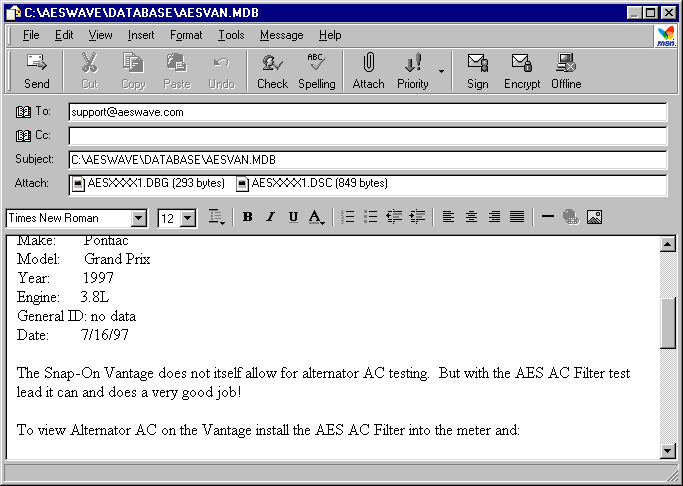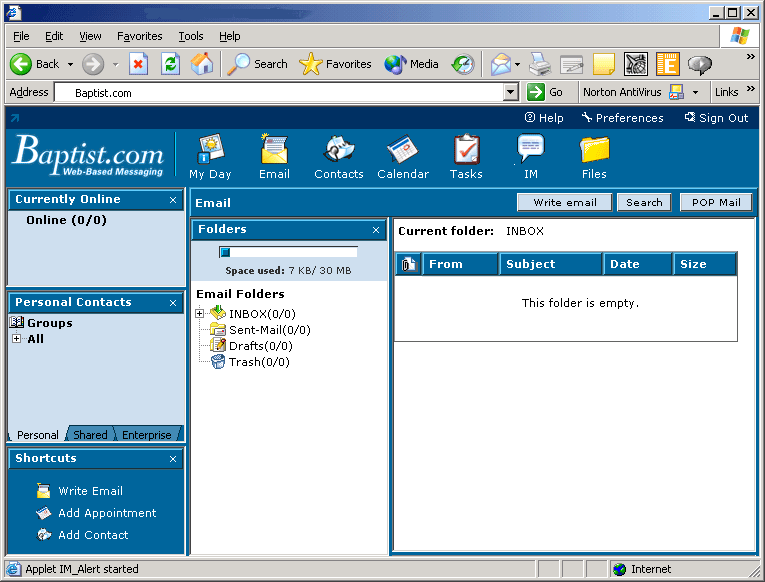Web
Genre Fluency 1
E-mail
(Electronic Mail)
What
is e-mail?
E-mail or electronic mail
has quickly become a popular method of communication. Ray Tomlinson first developed
e-mail in 1971 as a simple way to leave messages other users of the computer.
Shortly following its initial development, Tomlinson used the @ to designate
users at different computers and took advantage of  a
file sharing program to transmit messages or e-mails between computers. Today,
e-mail is used by billions of people world wide. From business men to stay-at-home
moms to teenagers to young schoolchildren; almost everyone has found a way to
utilize the benefits of instantaneous communication that email provides.
a
file sharing program to transmit messages or e-mails between computers. Today,
e-mail is used by billions of people world wide. From business men to stay-at-home
moms to teenagers to young schoolchildren; almost everyone has found a way to
utilize the benefits of instantaneous communication that email provides.
E-mail’s ease of use
contributes to its worldwide popularity. Hundreds of free email providers exist
on the World Wide Web. Popular sites like Hotmail,
Yahoo, AOL,
and Juno allow users to use their email
services and provide them with storage space at absolutely no charge. By filling
out a simple registration form and picking a domain name anyone with access
to a computer and an internet connection can find themselves connected to billions
of other internet users.
E-mail is used for different
purposes by different people. Advertisers use it to reach many people quickly
and efficiently. Business people use it to communicate messages through the
office and to save paper. People can stay in contact with people on the other
side of the world. E-mail is used very frequently by college students world
wide. Most schools provide students with email addresses. This makes it easier
to contact the student body. With e-mail it is easy to send out one message
to reach hundreds or even thousands of people. It is versatile and much cheaper
than sending a letter through the mail. Email also makes it easy to send pictures,
documents and other files incredibly quickly.

While each company uses
a different interface, using e-mail is pretty
standard throughout the World Wide Web. Each site features
an inbox where all of your incoming messages are stored. The inbox allows users
to click on messages, read them, and ultimately choose whether to delete or
save the message. E-mail also gives the user the option of directly replying
to each individual message. Most e-mail services also feature an address book
option. The address book is a place to store e-mail addresses for quick and
easy access. Some programs go even farther and offer calendar and planner options
and will send users reminder e-mails of upcoming events.
A problem that has been
encountered with email, as in most written forms of communication, is a lack
of emotion. Without voice tone and pitch it is hard to detect sarcasm, excitement,
and other emotions. Programs have attempted to combat this problem with the
use of emoticons. Emoticons are visual images inserted into text of an email.
The first emoticons were built with normal key board strokes: a winking face
;) Visit the Emoticon
Dictionary additional common expressions. Often they look like cartoon faces
depicting a certain emotion. Many companies have taken emoticons a step further.
You can download
actual smiley images or animations to place in your personal e-mails.
Back
to Top
Experience
I began using e-mail in
high school when I opened my very own Hotmail account. I was very proud to share
my e-mail address with my friends and we began to send messages back and forth.
Then, e-mail was basically a form of entertainment. Today e-mail serves many
purposes. I maintain five different e-mail accounts where I communicate in many
ways, both for information and entertainment. I can keep in contact with my
friends who live all around the world. I can quickly and easily contact classmates
and professors. I have joined several e-mail groups, called listservs, where
I can receive e-mails from people with a similar interest. Join a listserv at
Yahoo!Groups. I also have signed up to
receive e-mails from certain companies and stores where I frequently shop. E-mail
has made communication quicker and easier in many ways.
Back
to Top
Advice
The key to effective e-mail
communication is writing concise and directed messages. In this fast paced world
there is not enough time to sift through every message sitting in the inbox.
Your message should be short, simple, and to the point. See Gerry
Reid's tips for using e-mail to enhance your professional image.
It is important to use a
recognizable e-mail address and a subject that directly leads in to your message.
This will prevent your message from being confused with spam messages that bombard
inboxes world wide.
E-mail etiquette is an important
factor. Many young people have adopted a sort of online shorthand featuring
phrases like ttyl, j/k, and btw. Click
for a technical short hand dictionary. Additionally, rules of punctuation and
grammar are not followed. The word I is often not capitalized, and you is shortened
to a simple u. This type of writing is not respected in the academic and the
business world. It is important to avoid this type of communication in a professional
e-mail.
The World Wide Web while
incredibly useful can also be very frustrating. E-mail used for more than communication.
Viruses can quickly and easily spread around the world and email is often a
carrier. It is important to know the source of your e-mails before you open
them.
E-mail has become an integral
part of our everday lives. Therefore, it is important to be able to communicate
effectively in this genre. Mediacollege.com provides a top ten list featuring
the Top Ten Tips
for Using Email.
Back
to Top
 a
file sharing program to transmit messages or e-mails between computers. Today,
e-mail is used by billions of people world wide. From business men to stay-at-home
moms to teenagers to young schoolchildren; almost everyone has found a way to
utilize the benefits of instantaneous communication that email provides.
a
file sharing program to transmit messages or e-mails between computers. Today,
e-mail is used by billions of people world wide. From business men to stay-at-home
moms to teenagers to young schoolchildren; almost everyone has found a way to
utilize the benefits of instantaneous communication that email provides. 